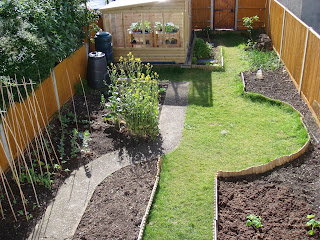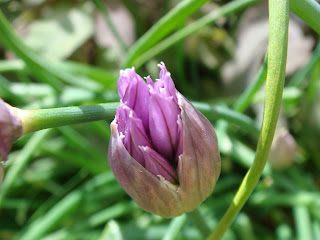...but the difference was negligible.
The one on the right in the terracotta-coloured pot has a label that says Moneymaker, which makes it a good match for the greenhouse tomatoes, as those are also both Moneymaker. The one in the middle has a label that says "Rocket", so that doesn't speak well of my labelling practices, and, worse, the one on the left has no label at all. I only grew three types of tomato this year: Moneymaker, Gardener's Delight and ones that had self-seeded in the garden, which I took out and put in the greenhouse in pots. Based on last year's crop, the self-seeded ones must be Moneymaker, Gardener's Delight or a cross-breed of the two. The ones in the unlabelled pot and mislabelled pot could be any of those, but are most likely to be Moneymaker because most of my Gardener's Delight seedlings died this year (I think I planted them without enough compost over them, and I only had a few seeds left anyhow) and I'm pretty sure I have the two self-seeded ones correctly labelled and waiting to be planted out after our second water butt arrives. At any rate, I'll have a much better idea of what type they are when they start producing tomatoes, as Moneymaker tomatoes are much larger than Gardener's Delight.
I have now planted the outdoor three in this experiment outside (on 27 May).
The one that's definitely Moneymaker (at least according to my labelling) is in the far right corner near the greenhouse. I've been a bit naughty. Given that last year my tomatoes completely took over their bed and obliterated all the weeds in it, I've decided to grow this year's in among some flowers in the hope that the flowers will be pretty and then the tomatoes will take over everything afterwards.
The flowers are in fact a mixture of seeds that had fallen out of their packets in my bag of flower seeds (I keep my seeds in sandwich bags by type so I can find the ones I want more easily). Based on the leaves, I'd say I have ornamental poppies near the path and love-in-a-mist further back. I have the suspicion that the tomatoes are going to take over everything before the others manage to flower (partly because I came up with the idea too late to plant love-in-a-mist in time to flower at their earliest), but we shall see.
For this experiment, I'm interested in:
* which tomato plants flower and produce fruit earliest,
* which get biggest
* if there is any clear difference in the amount of tomatoes produced
* any difference in problems (greenfly, disease etc.).
My plan is to try and feed the ones inside and outside the greenhouse once a week (or at any rate, on the same day as each other).
In other news, all the corn is now planted.
And most (but not all) of the plants that are going to be planted have been:













































